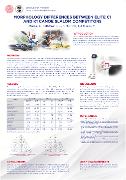Morphology Differences Between Elite C1 and K1 Canoe Slalom Competitors

Autor
Hellebrand, Jaroslav
Macas, Tomáš
Real Federación Española de Piragüismo
Datum vydání
2022Metadata
Zobrazit celý záznamKolekce
Abstrakt
Introduction: Anthropometric and strength parameters are important factors of the white water slalom performance. However, differences between kayak (K1) and canoe (C1) category are still unknown. The aim of this study is to identify if morphology and strength differences existed between kayak and canoe paddlers.Methods: The survey included a total of 30 (15 C1 and 15 K1) canoe slalom paddlers who competed in the 2022 ICF Canoe Slalom World Cup in Prague. These competitors were assessed using a battery of anthropometric dimensions according to standardized anthropometric techniques, bioimpedance analysis using the multifrequency octopolar device Tanita MC-980 and Takei 5401 handgrip digital dynamometer. Two days before the World Cup event, paddlers were assessed on consecutive days. To eliminate inter-rater variability, all measurements were conducted by a single experienced examiner.Results: There are no significant anthropometric and strength differences between C1 and K1 paddlers. Elite slalom male competitors can be characterized to having average body height (~180 cm), average weight (~75 kg), with ectomorphic mesomorph somatotype, well developed trunk and arm muscles, highly above average hand-grip strength (~55 - 60 kgf-1), low hypertrophy of legs and low body fat (~8 - 9 %).Conclusions: Generally, canoe slalom performance is likely to be disadvantaged, if the athlete has large physiognomy. Body weight over 80 kg in male elite paddlers is rare, similarly body height greater than 190 cm. We suggest developing strength without excessive leg hypertrophy. It is probably necessary in canoe slalom to have very well developed muscles of the chest and arms and keep body fat contribution very low.
Klíčová slova
kayak, canoe, somatotype, anthropometry
Trvalý odkaz
https://hdl.handle.net/20.500.14178/2102Licence
Tento výsledek je zpřístupněn v režimu gratis open access, tj. pouze pro čtení. V souladu s § 30 zákona č. 121/2000 Sb., autorského zákona, lze plný text z repozitáře také stáhnout, případně vytisknout, ale pouze pro osobní potřebu.




